Related Research Articles

Francis II was King of France from 1559 to 1560. He was also King of Scotland as the husband of Mary, Queen of Scots, from 1558 until his death in 1560.
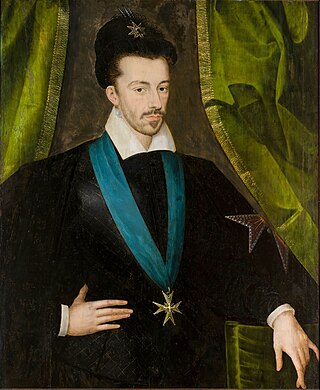
Henry III was King of France from 1574 until his assassination in 1589, as well as King of Poland and Grand Duke of Lithuania from 1573 to 1575.

The French Wars of Religion were a series of civil wars between French Catholics and Protestants from 1562 to 1598. Between two and four million people died from violence, famine or disease directly caused by the conflict, and it severely damaged the power of the French monarchy. One of its most notorious episodes was the St. Bartholomew's Day massacre in 1572. The fighting ended with a compromise in 1598, when Henry of Navarre, who had converted to Catholicism in 1593, was proclaimed King Henry IV of France and issued the Edict of Nantes, which granted substantial rights and freedoms to the Huguenots. However, Catholics continued to disapprove of Protestants and of Henry, and his assassination in 1610 triggered a fresh round of Huguenot rebellions in the 1620s.

The House of Guise was a prominent French noble family that was involved heavily in the French Wars of Religion. The House of Guise was the founding house of the Principality of Joinville.

Charles de Lorraine, duc de Mayenne was a French noble, governor, military commander and rebel during the latter French Wars of Religion. Born in 1554, the second son of François de Lorraine, duke of Guise and Anne d'Este, Mayenne inherited his fathers' position of Grand Chambellan in 1563 upon his death. He fought at the siege of Poitiers for the crown in 1569, and crusaded against the Ottomans in 1572. He served under the command of the king's brother Anjou during the siege of La Rochelle in the fourth war of religion, during which he was wounded. While the siege progressed, his uncle was killed by a cannonball, and he inherited his position as governor of Bourgogne. That same year, his marquisate of Mayenne was elevated to a duché pairie. He travelled with Anjou when he was elected as king of the Commonwealth and was a member of his court there until early 1574 when he departed on crusade again. Returning to France, he served in the fifth war of religion for Anjou, now king Henri III of France, but his badly underfunded army was unable to seriously impede the Protestant mercenary force under Casimir. He aligned himself with the Catholic Ligue that rose up in opposition to the generous Peace of Monsieur and fought in the sixth war of religion that resulted, serving at the sieges of La Charité-sur-Loire and Issoire. During 1576, he married Henriette de Savoie-Villars, securing a sizable inheritance in the south west, and the title of Admiral on the death of her father in 1578. Mayenne was granted full command of a royal army during the seventh war of religion in 1580, besieging the Protestant stronghold of La Mure successfully, and clearing several holdout towns after the peace. In 1582 he was obliged to surrender his title of Admiral to Joyeuse, a favourite of Henri. The following year he was involved in an abortive plan to invade England, though it came to nothing due to lack of funds.

Henry I, Prince of Joinville, Duke of Guise, Count of Eu, sometimes called Le Balafré ('Scarface'), was the eldest son of Francis, Duke of Guise, and Anna d'Este. His maternal grandparents were Ercole II d'Este, Duke of Ferrara, and Renée of France. Through his maternal grandfather, he was a descendant of Lucrezia Borgia and Pope Alexander VI.
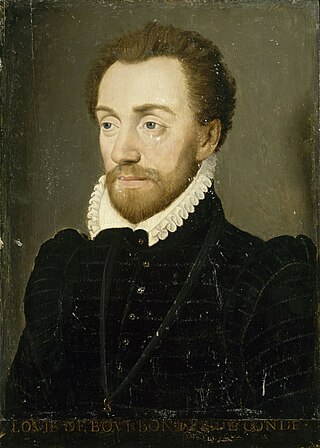
Louis de Bourbon, 1st Prince of Condé was a prominent Huguenot leader and general, the founder of the Condé branch of the House of Bourbon. Coming from a position of relative political unimportance during the reign of Henri II, Condé's support for the Huguenots, along with his leading role in the conspiracy of Amboise and its aftermath, pushed him to the centre of French politics. Arrested during the reign of Francis II then released upon the latter's premature death, he would lead the Huguenot forces in the first three civil wars of the French Wars of Religion before being executed after his defeat at the Battle of Jarnac in 1569.
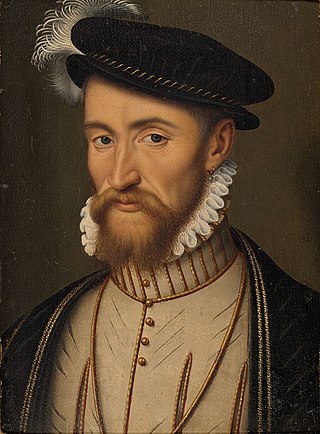
Francis I of Lorraine, 2nd Duke of Guise, 1st Prince of Joinville, and 1st Duke of Aumale, was a French general and statesman. A prominent leader during the Italian War of 1551–1559 and French Wars of Religion, he was assassinated during the siege of Orleans in 1563.
The War of the Three Henrys, also known as the Eighth War of Religion, took place during 1585–1589, and was the eighth conflict in the series of civil wars in France known as the French Wars of Religion. It was a three-way war fought between:

François de Montmorency, 2nd Duke of Montmorency was a French noble, governor, diplomat and soldier during the latter Italian Wars and the early French Wars of Religion. The son of Anne de Montmorency, favourite of the king and Madeleine of Savoy, Montmorency began his political career during the coronation of Henri II in 1547. With the resumption of the Italian Wars in 1551 he fought at the capture of Chieri, the famous defence of Metz and the defence of Thérouanne. In the latter engagement he was captured by Imperial forces, and put up for ransom. He would spend the next three years in captivity before returning to France in 1556. Returning to the conflict immediately he participated in the disastrous Saint-Quentin campaign in which the French army was destroyed and his father captured. After serving as a lieutenant in Picardie he found himself gaining advantage on the death of Henri II, the new Guise regime compensating the Montmorency family for their seizure of the grand maître title with the provision of a Marshal baton to Montmorency.

Jacques de Savoie, duc de Nemours was a French military commander, governor and Prince Étranger. Having inherited his titles at a young age, Nemours fought for king Henri II during the latter Italian Wars, seeing action at the siege of Metz and the stunning victories of Renty and Calais in 1554 and 1558. Already a commander of French infantry, he received promotion to commander of the light cavalry after the capture of Calais in 1558. A year prior he had accompanied François, Duke of Guise on his entry into Italy, as much for the purpose of campaigning as to escape the king's cousin Antoine of Navarre who was threatening to kill him for his extra-marital pursuit of Navarre's cousin.
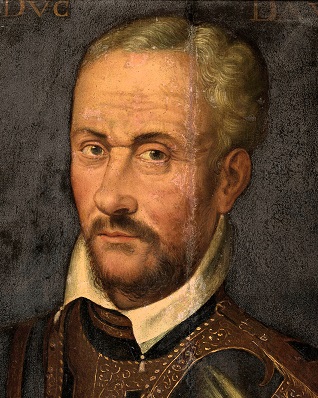
Claude II de Lorraine, duc d'Aumale was a Prince étranger, military commander and French governor, during the latter Italian Wars and the early French Wars of Religion. The son of the first Duke of Guise he started his career in a pre-eminent position in French politics as a son of one of the leading families in the court of Henri II of France. Upon the death of his father in 1550, Aumale inherited the governorship of Burgundy from his father, and the duchy of Aumale from his brother who assumed the titles of Guise. Aumale was made colonel-general of the light horse by the new king and fought in Italy, Alsace and Picardie between 1551 and 1559. While leading the light cavalry during the defence of Metz he was captured, and held for the next two years, until his mother in law Diane de Poitiers paid his ransom. He achieved success at the siege of Volpiano and played an important role in the capture of Calais for which he was rewarded with the governorship of French Piedmont.

Louis de Lorraine, cardinal de Guise et prince-évêque de Metz was a French Roman Catholic cardinal and Bishop during the Italian Wars and French Wars of Religion. The third son of Claude, Duke of Guise and Antoinette de Bourbon he was destined from a young age for a church career. At the age of 18 he was appointed Bishop of Troyes, a position he could only serve in an administrative capacity as he would not reach the Canonical Age for another 9 years. Having served in this position for 5 years, he transferred to become Bishop of Albi, staying in this role until 1561, when he was replaced due to his lethargic suppression of 'heresy'. From here he moved to become Archbishop of Sens, a see he would hold from 1561 to 1562, during which time a massacre of Protestants would occur in the city. By 1562 he decided to retire from active episcopal involvement. Nevertheless, he would become Prince-Bishop of Metz in 1568, an office he would hold until his death a decade later. While he lacked much interest in spiritual matters and was renowned for his drinking, he built up a considerable empire of abbeys during his life, which he passed on to his nephew Claude, chevalier d'Aumale.
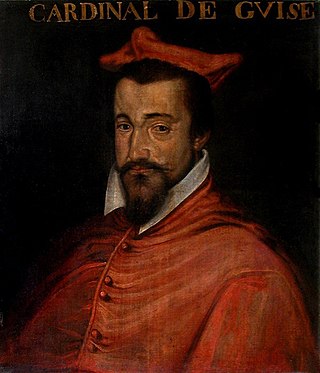
Louis II de Lorraine, cardinal de Guise was a French prelate, Cardinal and politician during the latter French Wars of Religion. The third son of François de Lorraine, duke of Guise and Anne d'Este Louis was destined for a career in the church. His uncle Cardinal Lorraine resigned his offices of Archbishop of Reims to him in 1574, and the death of his other uncle Louis I de Lorraine, Cardinal de Guise passed his ecclesiastical empire on to him upon his death in 1578. At which time the king made him Cardinal. Cardinal Guise actively involved himself in the first Catholic Ligue that rose up in opposition to the generous Peace of Monsieur which brought the fifth war of religion to a close in 1576. The ligue succeeded in resuming the civil war the next year and a harsher peace was concluded. Over the following years of peace, he would feud with Épernon, and receive Henri III's new honour when he was made a chevalier de l'Ordre du Saint-Esprit in 1578 among the first cohort. Finally reaching the ecclesiastical age at which he could assume his responsibilities as Archbishop of Reims in 1583 he entered the city in triumph and oversaw a council at which he pushed for the promulgation of the Tridentine Decrees.

Charles de Lorraine, 4th Duke of Guise and 3rd Prince of Joinville, was the son of Henry I, Duke of Guise and Catherine of Cleves, and succeeded his father as Duke of Guise in 1588. Initially part of the Catholic league, he pledged his support for Henry IV of France and was made Admiral of the Levant by Louis XIII of France. After siding with the Queen Mother, Marie de' Medici, against Cardinal Richelieu, he fled to Italy with his family where he died in 1640.

The siege of Rouen was a key military engagement of the first French War of Religion. After having been seized by those opposing the crown on 16 April, the siege, beginning on 28 May and culminating on 26 October brought the important city of Rouen back into the crowns control. The fall of Rouen would set the stage for the main battle of the war at Dreux several months later.
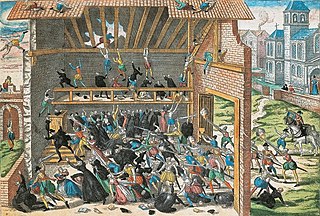
The Massacre of Vassy was the murder of Huguenot worshippers and citizens in an armed action by troops of the Duke of Guise, in Wassy, France on 1 March 1562. The massacre is identified as the first major event in the French Wars of Religion. The series of battles that followed concluded in the signing of the Peace of Amboise on 19 March 1563.
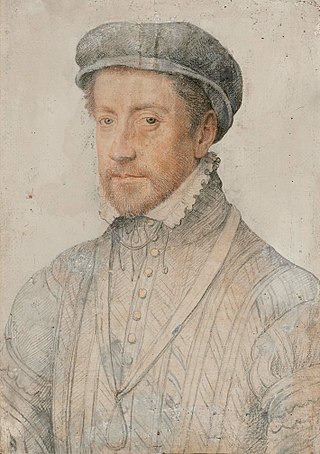
Louis de Bourbon, Duc de Montpensier was the second Duke of Montpensier, a French Prince of the Blood, military commander and governor. He began his military career during the Italian Wars, and in 1557 was captured after the disastrous battle of Saint-Quentin. His liberty restored he found himself courted by the new regime as it sought to steady itself and isolate its opponents in the wake of the Conspiracy of Amboise. At this time Montpensier supported liberalising religious reform, as typified by the Edict of Amboise he was present for the creation of.

The siege of Orléans was the final key military engagement of the first French War of Religion. Having lost the Battle of Dreux the rebel Huguenots fell back with their remaining forces to the city. François, Duke of Guise, the only non captive royal commander, moved to lay siege to the town, hoping its capitulation would bring about a total victory for the crowns forces. However, despite reducing the suburbs, he would be assassinated at the siege before he could bring it to a conclusion. As a result the captive Louis, Prince of Condé and Anne de Montmorency at Catherine de' Medici's direction were able to negotiate a compromise end to the first war in the Edict of Amboise.

Guy de Daillon, comte du Lude was a French governor and military commander during the French Wars of Religion. The son of Jean de Daillon, governor of Poitou from 1543 to 1557, Lude inherited his position in the province, becoming governor shortly after his father's death. In 1560 the province, which had been a subsidiary governorship under the governorship of Guyenne was reconfigured to an autonomous entity, and given to Antoine of Navarre to buy his loyalty to the Guise regime. Resultingly Lude was given the role of lieutenant-general of the province instead of governor. However this was functionally a promotion as, when governor of Poitou previously he was subordinate to Navarre's authority in Guyenne. Now when Navarre was absent he had the powers of an autonomous governor.
References
- 1 2 3 4 5 Campbell 2003.
- 1 2 3 Richards 2016, p. 177.